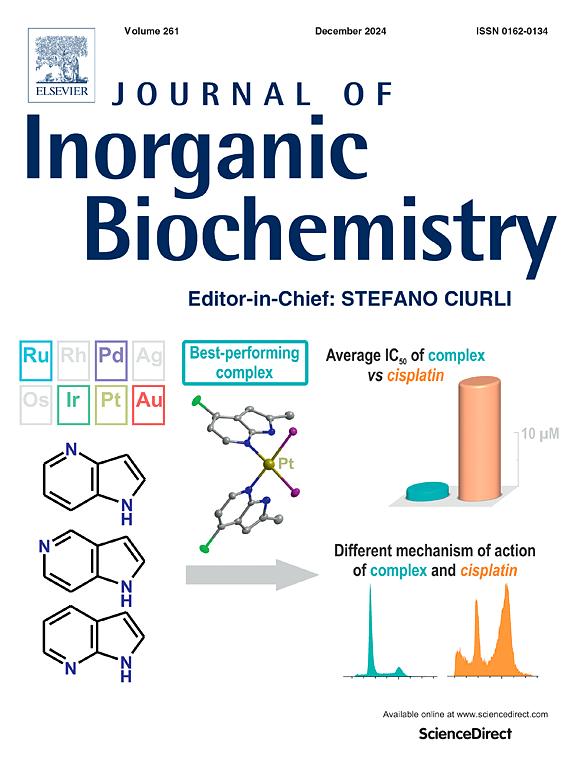Silacrown ethers as ion transport modifiers and preliminary observations of cardiovascular cell line response
IF 3.8
2区 化学
Q2 BIOCHEMISTRY & MOLECULAR BIOLOGY
引用次数: 0
Abstract
Crown ethers have been shown to have physiological effects ascribed to their ionophoric properties. However, high levels of toxicity precluded interest in their evaluation as therapeutic agents. We prepared new silacrown analogs of crown ethers. These initial studies focused on examples of large ring silacrown ethers having at least fourteen ring atoms with at least one lipophilic or hydrophobic substituent on the ring and/or on the silicon atom. The synthesis of silacrown ethers, ionophoric behavior, toxicity studies, and preliminary pharmacodynamic studies in cardiac myocyte cell lines are presented and compared to their carbon analogs. We report the effects of these compounds in HL-1 cells, an atrial muscle cell line with plasma membrane and sarcoplasmic reticulum Ca2+ channels that give rise to spontaneous Ca2+ transients driven by action potentials. Dicyclohexano-18-crown-6 and the silacrown equivalent dimethylsila-17-cyclohexanocrown-6 were both found to rapidly inhibit the Ca2+ transients after acute treatment, and these effects were reversed when extracellular KCl was increased to cause plasma membrane depolarization. The data suggest that the silacrowns can mimic the effects of crown ethers with similar ring sizes, and this appears to be due to their effects on membrane potential and suppression of action potential firing.

硅冠醚作为离子转运调节剂及心血管细胞系反应的初步观察。
冠醚已被证明具有生理效应归因于其电离性的性质。然而,高水平的毒性阻碍了对其作为治疗剂进行评估的兴趣。我们制备了冠醚的新型硅冠类似物。这些最初的研究集中在具有至少14个环原子的大环硅冠醚的例子上,环和/或硅原子上至少有一个亲脂或疏水取代基。介绍了硅冠醚的合成、离子行为、毒性研究和心肌细胞系的初步药理学研究,并与它们的碳类似物进行了比较。我们报告了这些化合物在HL-1细胞中的作用,HL-1细胞是一种心房肌细胞系,具有质膜和肌浆网Ca2+通道,可引起由动作电位驱动的自发Ca2+瞬态。二环己烯-18-冠-6和硅冠等效物二甲基硅烷-17-环己烯-6在急性治疗后均能迅速抑制Ca2+瞬态,当细胞外KCl增加导致质膜去极化时,这些作用被逆转。数据表明,硅冠可以模仿具有相似环大小的冠醚的作用,这似乎是由于它们对膜电位的影响和对动作电位放电的抑制。
本文章由计算机程序翻译,如有差异,请以英文原文为准。
求助全文
约1分钟内获得全文
求助全文
来源期刊

Journal of Inorganic Biochemistry
生物-生化与分子生物学
CiteScore
7.00
自引率
10.30%
发文量
336
审稿时长
41 days
期刊介绍:
The Journal of Inorganic Biochemistry is an established international forum for research in all aspects of Biological Inorganic Chemistry. Original papers of a high scientific level are published in the form of Articles (full length papers), Short Communications, Focused Reviews and Bioinorganic Methods. Topics include: the chemistry, structure and function of metalloenzymes; the interaction of inorganic ions and molecules with proteins and nucleic acids; the synthesis and properties of coordination complexes of biological interest including both structural and functional model systems; the function of metal- containing systems in the regulation of gene expression; the role of metals in medicine; the application of spectroscopic methods to determine the structure of metallobiomolecules; the preparation and characterization of metal-based biomaterials; and related systems. The emphasis of the Journal is on the structure and mechanism of action of metallobiomolecules.
 求助内容:
求助内容: 应助结果提醒方式:
应助结果提醒方式:


